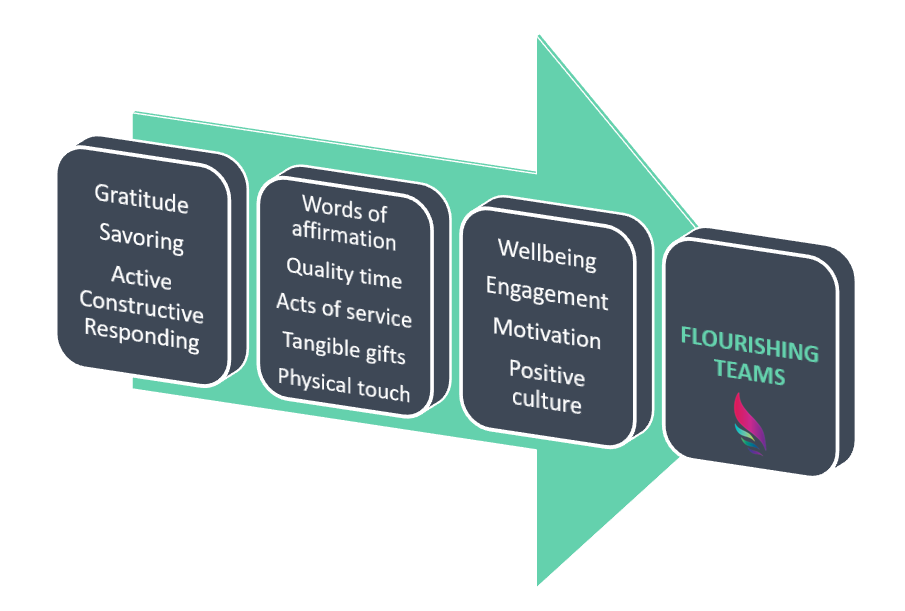
In today’s fast-paced corporate world, where deadlines loom and pressures persist, it is crucial for organizations to create an environment that fosters employee wellbeing, engagement, and motivation. One often overlooked yet powerful tool for achieving this lies in the celebration of success and the practice of genuine recognition. Let’s explore the connection between recognition, positive psychology principles, and employee wellbeing, drawing insights from Gary Chapman’s “Five Languages of Appreciation in the Workplace.”
Recognition holds significant importance in promoting employee satisfaction and overall wellbeing. However, it is important to move beyond traditional notions of recognition centered solely on financial rewards and annual events. Instead, organizations should focus on the daily small actions that leaders can take to make a meaningful difference in their employees’ lives. Positive psychology principles play a vital role in cultivating a culture of recognition and celebrating success.
Gratitude, for example, has a profound impact on individual and team performance. Encouraging leaders to express sincere appreciation and fostering a culture of gratitude within the organization can significantly contribute to employee wellbeing.
Savoring achievements, both big and small, is another aspect of positive psychology that enhances flourishing in the workplace. Embracing the art of savoring success, coupled with mindfulness practices, enables employees to relish their accomplishments and share their stories, leading to a more positive work environment.
Active Constructive Responding is a powerful communication style for amplifying positivity within the workplace. Genuine interest in the employee’s experience and constructive responses empower leaders to engage in active conversations, building a supportive and collaborative work environment that fosters employee engagement and motivation.
Along with the above-mentioned tools, Gary Chapman’s framework on the languages of appreciation at work, provides valuable insights into understanding how individuals prefer to receive appreciation. By familiarizing themselves with the five languages, HR professionals and leaders can tailor recognition efforts to meet employees’ unique needs at no additional costs.
Words of Affirmation are a potent language of appreciation. Leaders who can effectively communicate appreciation through meaningful and personalized praise can create a positive impact on employee wellbeing. The key is to be specific.
Quality Time spent with employees is another language of appreciation that fosters meaningful connections. Encouraging one-on-one interactions and team-building activities allows leaders to actively listen and be fully present, further enhancing employee engagement and satisfaction.
Acts of Service demonstrate appreciation through actions and practical support. Identifying ways to help employees in their day-to-day work promotes a culture of support and collaboration, contributing to overall wellbeing.
Tangible Gifts, when aligned with individual preferences and needs, can serve as symbolic tokens of appreciation. Balancing meaningful gestures with the organization’s resources ensures that employees feel valued and recognized. It is not the price of a gift, but the meaning behind it that adds value.
Physical Touch, when appropriate and respectful, and as simple as a high five or a handshake can be a language of appreciation for some individuals. However, it is crucial to consider boundaries and cultural considerations to create a safe and inclusive environment for all employees.
Celebrating success and recognizing employee contributions are integral to fostering wellbeing, engagement, and motivation within an organization. By embracing positive psychology principles such as gratitude, savoring, and active constructive responding, along with insights from Gary Chapman’s Five Languages of Appreciation in the Workplace, HR professionals can create a workplace culture where individuals feel valued, supported, and empowered. Remember, it is not just the grand gestures but the daily small actions that make a lasting impact on employee wellbeing and success. Let us make recognition an integral part of our organizational DNA and reap the benefits of a flourishing workforce.
Presented by

Archives
Categories
- Attraction and Recruitment
- Benefits
- Celebrating Success and Recognition
- Change Management
- Coaching and Conflict Resolution
- Culture
- Diversity, Equity and Inclusion
- Emotional Intelligence
- Employee Engagement
- Employee Performance
- Labour Disruption
- Mentoring
- OMHRA activities
- OMHRA Events
- Psychological health and safety of the HR professional
- Recruitment
- Recruitment and Retention
- Retention
- Uncategorized
- Unique ideas for recruiting in a tight job market
- Wellness
Recent Posts
- How Leadership Development Coaching Provides Better Outcomes
- Better Leadership: Focus on a Coach Approach
- Creating a Psychologically Safe Workplace
- Group Health Insurance – The Impact of Preferred Pharmacy Networks on Employees’ Mental Health
- Provide Real Support For Your Mid-Career Team’s Psychological Resilience
